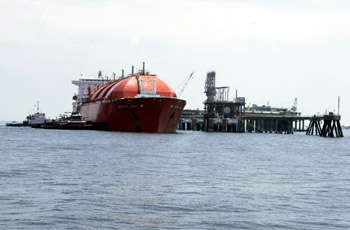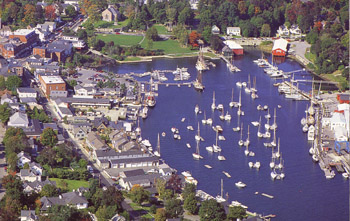Rough Seas For LNG
by Jeff Della Penna
|
Fishermen find themselves once again at the bottom of the pecking order as another LNG (Liquid Natural Gas) company tries to get its foot in the door along Maine’s coast. First fishermen and community activists locked horns with Fairwinds, a joint proposal by ConocoPhillips Co. and TransCanada Pipelines Ltd., to build a $350 million LNG terminal at Harpswell Neck. Another potential site is Sears Island in Searsport, that particular site saw opposition but is still pending. Then fishermen and community members headed off a Nales-Cianbro LNG proposal for the old Corea Naval Base, near Gouldsboro. Now, Cobscook Bay area activists and fishermen are organizing against a Tulsa, Oklahoma company’s plan to build a $300 million LNG terminal at Gleason Cove, on Pleasant Point Passamaquoddy property, near the fishing towns of Perry, Eastport and Lubec. Has politics finally caught up with the fight to protect traditional fishing grounds from developments such as LNG terminals? If so, some of Maine’s most important lobster, clam, scallop and urchin fisheries may be on the line.
While the NIMBY (Not In My Backyard) syndrome may have pushed the LNG proposals up the coast and into the poorest of Maine’s communities, the biggest surprise for Gulf of Maine fishermen may come in the form of federal action that could slap “Home Rule” and community sovereignty right in the face. Cobscook Bay fishermen may be the first to get an energy project jammed down their collective throat, but, as is being proven in Gloucester, Mass (with the proposal to run a 10 mile LNG gas line through the middle of the local lobster fishery), solutions to our country’s growing energy problems and potential tax revenues seem to win out over fishing interests and environmental common sense almost every time,
|

A problem with an LNG facility or tanker in the Cobscook Bay could potentially affect some 170 licensed lobstermen, 160 “licensed” clammers, 85 scallop draggers, 15 scallop divers, 250 commercial fishing license holders, 85 urchin license holders, and a handful of marine worm, eel/elver, commercial shrimp, seaweed, mussel, mahogany quahog and green crab license holders. .Photo U.S. Coast Guard |
The Cobscook Bay LNG proposal is unique in that the gas company, Quoddy Bay LLC, avoided an immediate showdown with the regional town governments and property owners by selecting a site owned by the Passamaquoddy and Sipayik nations. Quoddy Bay’s point man, Jim Mitchell (reported to be one of the highest paid lobbyist in Augusta), is now trying to quiet local opposition with promises of tax support and
continue
|
|
|
Farmer Johnson's Cornfield
by Mike Crowe
|
Since the earliest days of settlement, the coast has been central to economic life in the state of Maine. For centuries, the only practical access was by sea. Fishing was based in coastal towns, while agricultural and forest products came down the rivers to be shipped from the coast. Even after enough good roads were built to make automobile travel more practical in the 1940’s, most of the coast retained it’s rural village character.
But the last few decades have seen sudden dramatic changes. People in many towns have met to discuss soaring property taxes. Many of the same questions are asked, the same answers given, the same concerns expressed and the same frustrations felt over the lack of good solutions.
continue
|
 Valhalla, a term coined by author and sprawl critic Joel Kotkin, to describe an attractive town favored by the super-rich. It attracts “starter castles” and monster homes funded in part by federal tax law. That law allows interest and points on a principal of up to $1 million, to be deducted from income taxes every year. Mother-in-law coming for a visit? Not to worry, two of these residences and the real estate taxes can be deducted each year. In addition to raising the valuation of all homes in the harbor, the “Mansion Subsidy” induces tear-downs of buildings of scale and historic importance. Airphoto - Jim Wark, from A Field Guide to Sprawl, by Delores Hayden Valhalla, a term coined by author and sprawl critic Joel Kotkin, to describe an attractive town favored by the super-rich. It attracts “starter castles” and monster homes funded in part by federal tax law. That law allows interest and points on a principal of up to $1 million, to be deducted from income taxes every year. Mother-in-law coming for a visit? Not to worry, two of these residences and the real estate taxes can be deducted each year. In addition to raising the valuation of all homes in the harbor, the “Mansion Subsidy” induces tear-downs of buildings of scale and historic importance. Airphoto - Jim Wark, from A Field Guide to Sprawl, by Delores Hayden |
|
|
  
|
|

